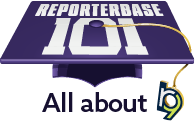Lesson #21
Production – Tracking function
Track items as they move through your production workflow and into storage — including the location of physical media such as DVDs. You can also use the Tracking function to track products you are entrusted with — such as videos and exhibits.
If you have different people handling a service item from start to finish — and/or many service items to produce — use Tracking to ensure nothing slips through the cracks and you always know where something is and its current status.
Tracking is optional and independent from other modules in RB9; i.e., item tracking is not initiated from jobs or Turn In. You set up Tracking to match your production workflow so you can track items as they move through the process.
Track what you want how you want
First define item types to be tracked. You can track electronic and physical files — such as finished transcripts, exhibits, video, and archived files — and processes — such as editing, scanning, and synching.
After setting up item types to be tracked, create steps that each kind of item goes through in your production workflow. If an item passes through different departments or staffers as it is produced and completed, you can add alerts to specific steps to automatically notify people when the item is their responsibility. And when you move an item to the last step in the workflow RB9 will automatically change its status from “In Progress” to “Completed.”
After defining item types and creating tracking steps specify codes for different areas in tracking:
- Archival Status: Current stored status of original media — such as video tapes. Some typical designations are Archived Here, Originals Destroyed, and Originals Sent To.
- Media Classification: Specifies who has rights to view/handle the media. Designations might include Attorney’s Eyes Only, Confidential, and Under Protective Order.
- Media Format: Types of media you produce — such as Audio Tape, CD, DV-CAM, and DVD-R.
- Priority: Specifies order of importance or urgency — such as High, Normal, and Urgent.
As with all lists in RB these come with a set of defaults so you don’t have to start from scratch. You can customize RB lists by editing the defaults, deleting defaults, and adding your own list options.
Tracking can be initiated as soon as a job is created (scheduled). Or use the Production Sheet as a guide for which service items to track through production. Then keep the status of items being tracked current by updating tracking information as the items move through production and into storage.
Customize how you view tracking lists
The grid in which you view tracked items is customizable to your individual preference:
- Re-arrange the columns so the most important information is most prominent
- Stick up to 10 columns to the left side of the grid so they do not scroll when you have a results grid wider than your screen.
- Stretch/shrink columns to fit the results.
- Hide columns you don’t need to see.
- Choose which column(s) to sort results by.
- If you select more than one column, choose in what column order to sort the list.
- Choose whether to sort info by ascending or descending order in each selected column.
- Save your custom grid as your default.
You can save your custom grid as your default. Your customizations do not affect other users and you can restore the original RB grid layout anytime.
From the Tracking results grid you can view and update any listed task’s details, start new trackings, and export the grid as an Excel spreadsheet or a CSV(comma-separated values) file to save, print, share, or use in other applications.
NOTE: This is an RB9-only function. It is not included in RB Lite.
TL;DR: Keep track of where items are in your production cycle and physically in your office.
Related RB concepts
Job: Usually the reporting of a deposition but can also be any kind of service you provide with your reporters or other resources. More >
Resource: Person or thing that provides your business with a service — such as reporters, videographers, interpreters, scopists, account executives, other agencies that cover jobs for you, or a conference room.

